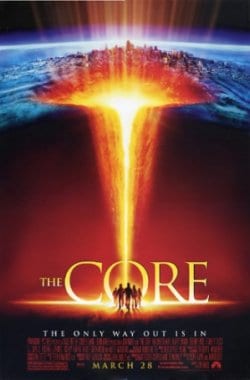
Courtesy: Paramount Pictures
By James Dacey at the AGU in San Francisco
A number of strange events including bizarre weather patterns and mass migrations of birds have led people to fear that something is going seriously wrong with the Earth’s magnetic field. In the US, a brilliant though dishevelled geophysicist believes the situation is due to a slowing in the rotation of the Earth’s core, the site where the field is generated.
When the US government caught wind of these claims, they had the scientist escorted to a secret meeting location where he delivered a short lecture on the fundamentals of geomagnetism. He warned that if the field vanishes entirely, the Earth will lose its protective shield and be exposed to a torrent of lethal radiation from the Sun.
Once they were sufficiently convinced by the passionate but uncooperative scientist, the government concluded that there is only one viable solution: they will drill down to the centre of the Earth and nuke the core into moving again.
Don’t worry. This is not a serious news story.
This is the plot to The Core, the 2003 disaster film, which grossed more than $70 million at the box office. On Tuesday night, The Core‘s director, Jon Amiel was talking at the American Geophysical Union (AGU) Fall Meeting here in San Francisco in a session about the representation of science in blockbuster films. In an entertaining presentation, Amiel discussed Hollywood’s obsession with geo disasters, from freak hurricanes to giant space rocks on collision paths with the Earth. He described how the idea of something going seriously wrong in the Earth’s interior appealed to him as another interesting spin on this theme.
After showing us some very funny clips from The Core, Amiel went on to discuss the question of whether Hollywood should try to represent science and scientists in an accurate way. Unsurprisingly, he believes that the success of a film comes from its ability to stir the emotions, and the aim of staying faithful to the science always comes second.
Amiel did, however, talk about his passion for the underlying science and all the geology he learned in making the film. “The Core articulates a good mystery story, like all great science,” he said.
Amiel was joined in the discussion by other speakers including Bruce Joel Rubin, who wrote the screenplay for Deep Impact, a film about a comet heading towards Earth, released in 1998. Rubin shared the same view about the importance of narrative but he believes there is no reason why film makers should shy away from including good science, so long as it is not to the detriment of the story. He described the extensive talks he carried out with geoscientists in predicting how a comet-impact with the Atlantic Ocean would trigger a tsunami that would wash away large parts of the US eastern seaboard and the low-lying areas of Europe.
“I really worked hard trying to make this film scientifically accurate,” he said. He contrasted his efforts to those of the makers of Armageddon, which was released in the same year and followed a similar plot. In this case, however, Bruce Willis is sent up to the approaching space rock to drill a bore hole and implant a nuclear device. He detonates the bomb, splitting the comet in half, and the world is saved.
Also on the panel was Sidney Perkowitz, condensed-matter physicist at Emory University in the US, who wrote this interesting article for Physics World back in 2006 about the way physicists are portrayed on screen.



